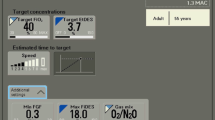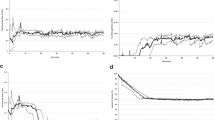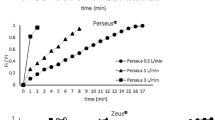Abstract
The FLOW-i anesthesia machine (Maquet, Solna, Sweden) can be equipped with automated gas control (AGC), an automated low flow tool with target control of the inspired oxygen concentration (FIO2) and end-expired concentration (FA) of a potent inhaled anesthetic. We examined the performance and quantitative aspects of the AGC. After IRB approval and individual informed consent, anesthesia in 24 ASA I–II patients undergoing abdominal or gynecological surgery was maintained with sevoflurane in O2/air with a target FIO2 of 40 % and a target sevoflurane FA (FAsevo) of 2.0 %. The AGC tool also allows the user to select 1 out of 9 different speeds with which the target FAsevo can be reached (with 9 being the fastest speed). Eight patients each were randomly assigned to speed 2, 4, and 6 (= group 2, group 4, and group 6, respectively); these three speeds were chosen arbitrarily. AGC was activated immediately after securing the airway, which defined the start of the study, and the study ended 60 min later. The following parameters were compared among the three groups: age, height, weight, FIO2, FAsevo, BIS values, heart rate, mean arterial blood pressure, fresh gas flow, and sevoflurane usage. Agent usage as reported by the FLOW-i was compared among the three groups. Patient demographics and maintenance FGF did not differ among groups. A very short-lived very high FGF (≈20 L min−1 for 8–12 s) ensured that the target FIO2 was attained within 1–2 min in all patients. FAsevo was 1.8 % after 15, 10, and 6 min, and 1.9 % after 30, 20 and 15 min in groups 2, 4, and 6, respectively. Blood pressure, heart rate, and BIS values did not differ among the three groups. BIS values remained acceptable in all patients, even with the slowest speed. Cumulative agent usage differed among all three groups between 2 and 30 min (lower with the lower speed), and between group 2 and 6 between 35 and 60 min. AGC combines an exponentially decreasing FGF pattern with a choice of ramp functions for the end-expired target concentration of the inhaled anesthetic. Consequently, both FGF and the choice of speed become factors that influence agent usage. After 15 min, a 300 mL min−1 maintenance FGF reduces agent usage to near closed-circuit conditions. This new addition to our automated low flow armamentarium helps to reduce anesthetic waste, cost, and pollution, while minimizing the ergonomic burden of low flow anesthesia.








Similar content being viewed by others
References
Body SC, Fanikos J, De Peiro D, Philip JH, Segal BS. Individualized feedback of volatile agent use reduces fresh gas flow rate, but fails to favorably affect agent choice. Anesthesiology. 1999;90:1171–5.
Lowe HJ, Ernst EA. The quantitative practice of anesthesia: use of closed circuit. Baltimore/London: Williams & Wilkins; 1981.
Avidan MS, Jacobsohn E, Glick D, Burnside BA, Zhang L, Villafranca A, Karl L, Kamal S, Torres B, O’Connor M, Evers AS, Gradwohl S, Lin N, Palanca BJ, Mashour GA, BAG-RECALL Research Group. Prevention of intraoperative awareness in a high-risk surgical population. N Engl J Med. 2011;365:591–600.
Kennedy RR, French RA. A ten-year audit of fresh gas flows in a New Zealand hospital: the influence of the introduction of automated agent delivery and comparisons with other hospitals. Anaesth Intensive Care. 2014;42:65–72.
Singaravelu S, Barclay P. Automated control of end-tidal inhalation anaesthetic concentration using the GE Aisys Carestation™. Br J Anaesth. 2013;110:561–6.
De Cooman S, Schollaert C, Hendrickx J, Peyton PJ, Van Zundert T, De Wolf AM. Hypoxic guard systems do not prevent rapid hypoxic inspired mixture formation. J Clin Mon Comp. (2014). Epub ahead of print 2014 Oct 1.
Hendrickx JFA, De Wolf AM, De Hert S. O2-anybody? [Editorial]. Eur J Anesth. 2015;32:371–3.
Dehouwer A, De Ridder S, Carette R, De Cooman S, De Wolf AM, Hendrickx JFA. How accurate is agent usage reported by automated low flow anesthesia machines? Accepted for presentation at the ESA annual meeting, May 31, 2015, Berlin, Germany [abstract, code 1AP19-9; abstract number 326].
De Cooman S, De Mey N, Dewulf BB, Carette R, Deloof T, Sosnowski M, De Wolf AM, Hendrickx JF. Desflurane consumption during automated closed-circuit delivery is higher than when a conventional anesthesia machine is used with a simple vaporizer–O2–N2O fresh gas flow sequence. BMC Anesthesiol. 2008;8:4.
Robinson GJ, Peyton PJ, Terry D, Malekzadeh S, Thompson B. Continuous measurement of gas uptake and elimination in anesthetized patients using an extractable marker gas. J Appl Physiol. 2004;97:960–6.
Heyse B, Proost JH, Hannivoort LN, Eleveld DJ, Luginbühl M, Struys MM, Vereecke HE. A response surface model approach for continuous measures of hypnotic and analgesic effect during sevoflurane–remifentanil interaction: quantifying the pharmacodynamic shift evoked by stimulation. Anesthesiology. 2014;120:1390–9.
Vereecke HE, Proost JH, Heyse B, Eleveld DJ, Katoh T, Luginbühl M, Struys MM. Interaction between nitrous oxide, sevoflurane, and opioids: a response surface approach. Anesthesiology. 2013;118:894–902.
Acknowledgments
The study has not been externally funded. The FLOW-i has been provided under a temporary loan contract. Jan Hendrickx has received lecture support, travel reimbursements, equipment loans, consulting fees and/or meeting organizational support from a number of companies involved with inhaled agent delivery (alphabetically): AbbVie, Acertys, Air Liquide, Allied healthcare, Armstrong Medical, Baxter, Draeger, GE, Hospithera, Heinen und Lowensein, Intersurgical, Maquet, MDMS, MEDEC, Micropore, Molecular, NWS, Philips, Quantum Medical.
Conflict of interest
The authors declare that they have no conflict of interest.
Ethical standard
The study has been approved by the IRB of the OLV hospital, Aalst, Belgium, part of OLV study number 2013/058, Belgian Registration number B126201317885.
Author information
Authors and Affiliations
Corresponding author
Rights and permissions
About this article
Cite this article
Carette, R., De Wolf, A.M. & Hendrickx, J.F.A. Automated gas control with the Maquet FLOW-i. J Clin Monit Comput 30, 341–346 (2016). https://doi.org/10.1007/s10877-015-9723-6
Received:
Accepted:
Published:
Issue Date:
DOI: https://doi.org/10.1007/s10877-015-9723-6




